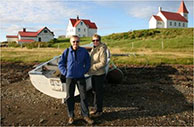Algeria – the South
Monday, 27 October 2025Having spent a week exploring the coast and north of Algeria – Algiers, east to Constantine and Setif, west to Oran, a number of Roman ruins sites – some of my group now head south to the Sahara. We’re going to spend five days trekking and camping through the Sahara, around the Tassili N’Ajjer plateau. This is not, however, the sandy dunes of the picturebook Sahara. Down here the Sahara is a rocky mountain expanse, you are constantly clambering over rocks and rubble. It is very hard work!
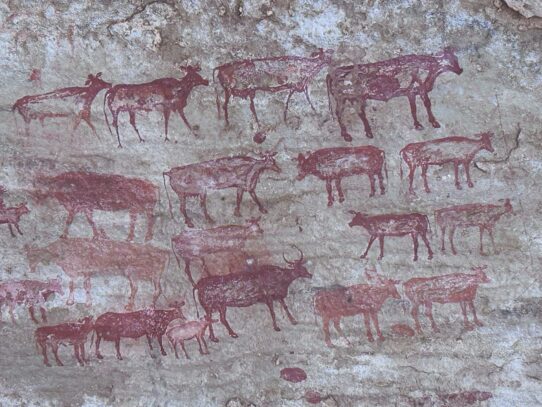 ▲ cattle rock art paintings on Day 2 of our Sahara trek
▲ cattle rock art paintings on Day 2 of our Sahara trek
What are we going to see in the Sahara – rock art, much like I encountered in Chad – along with amazing scenery and dead Russian tanks – back in 2022. The Russian tanks, despatched to invade Chad from Libya by Muammar Gaddafi, intent on grabbing Chad’s oilfields, were ambushed and wiped out by Chad ‘technicals,’ Toyota Hilux pickups toting anti-tank missiles. I suspect the Ukrainians took some lessons from Chad on how to deal with misguided Russians.
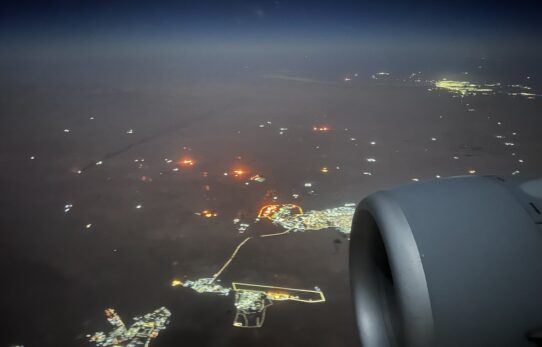 ▲ View from the Algiers-Djanet flight
▲ View from the Algiers-Djanet flight
Flights to the Algerian Sahara – either to Djanet or Tamanrasset – are all red-eyes. We depart Algiers at 2240 and it’s 0055 when we arrive in Djanet, down towards the corner where Algeria meets Libya and Niger. Coming back is even worse, we were scheduled to depart Djanet at 0130 and fly west to the other major Saharan outpost, Tamanrasset, then continue to Algiers with an ETA of 0555. Not a nice time to arrive anywhere although in fact our return flight runs ahead of schedule.

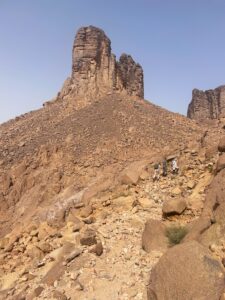 ▲ Here’s where we went on our five-day trek, a total of about 80km, starting with the long clamber up the gorge from our starting point on to the plateau. Was that almost a 700metre climb? It certainly started with 380metres on the first ascent and by the time we reached our camp that night I was absolutely beat.
▲ Here’s where we went on our five-day trek, a total of about 80km, starting with the long clamber up the gorge from our starting point on to the plateau. Was that almost a 700metre climb? It certainly started with 380metres on the first ascent and by the time we reached our camp that night I was absolutely beat.
◄ Oh my God, we are going to climb up that? Yes we are. Day 1 was absolutely the hardest part of the week, although it never got easy, even when the going was relatively horizontal you were still picking your way through rocks and rubble. I was constantly repeating to myself ‘careful, careful, careful’ because any stumble could be disastrous.
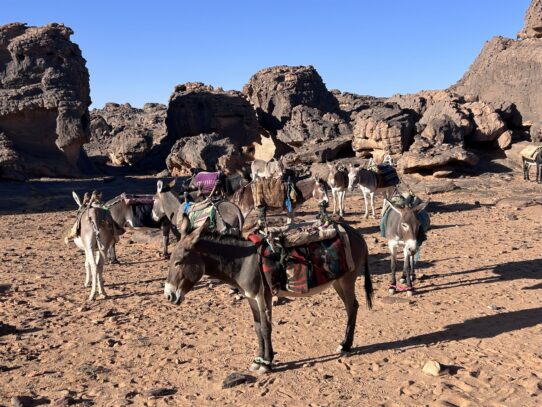 ▲ Loading up our donkeys on Day 3 – I didn’t want to end up on a ‘rescue donkey.’ We had 15 donkeys to carry our equipment, tents, food and water. And wine, there was a bottle of red every night. In fact I counted 16 or even 17 donkeys, we always have a spare donkey or two I was told. Sometimes they simply lose a donkey, when they get to the night’s camp one might have gone astray. Not a problem, we’ll find it next time we’re out here, the lost donkey will just head to the nearest waterhole and take a break from carrying camping gear. But also there always seemed to be a donkey or two without any load, if I’d fallen and broken an ankle I could have been carted home on the ambulance donkey. No thank you!
▲ Loading up our donkeys on Day 3 – I didn’t want to end up on a ‘rescue donkey.’ We had 15 donkeys to carry our equipment, tents, food and water. And wine, there was a bottle of red every night. In fact I counted 16 or even 17 donkeys, we always have a spare donkey or two I was told. Sometimes they simply lose a donkey, when they get to the night’s camp one might have gone astray. Not a problem, we’ll find it next time we’re out here, the lost donkey will just head to the nearest waterhole and take a break from carrying camping gear. But also there always seemed to be a donkey or two without any load, if I’d fallen and broken an ankle I could have been carted home on the ambulance donkey. No thank you!
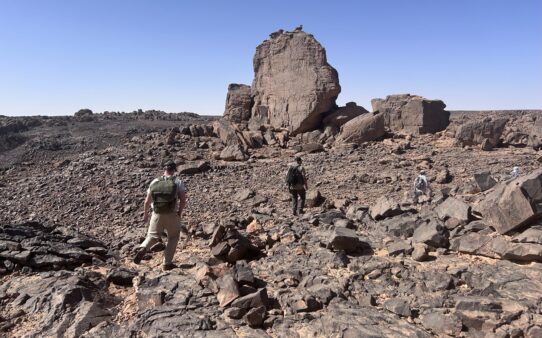 ▲ Typical walking territory – this was on Day 4. Up on the plateau, heading from one camp to another, the sites would always be reasonably close to a waterhole for the donkeys. How our guides knew where to find a waterhole I have no idea.
▲ Typical walking territory – this was on Day 4. Up on the plateau, heading from one camp to another, the sites would always be reasonably close to a waterhole for the donkeys. How our guides knew where to find a waterhole I have no idea.
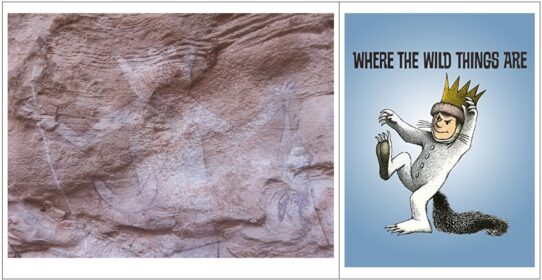 ▲ But I also had no idea how they knew where to find the rock art, there was an awful lot of it, but there’s even more rock where it might be hidden. On Day 2 we came to this artwork which I’m sure is where Maurice Sendak was inspired to create Max’s outfit for his children’s book Where the Wild Things Are.
▲ But I also had no idea how they knew where to find the rock art, there was an awful lot of it, but there’s even more rock where it might be hidden. On Day 2 we came to this artwork which I’m sure is where Maurice Sendak was inspired to create Max’s outfit for his children’s book Where the Wild Things Are.
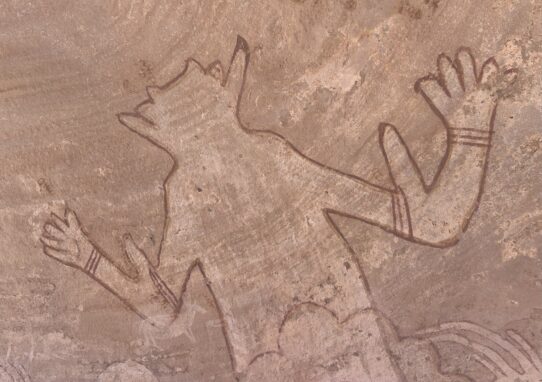 ▲ ‘The Aliens,’ no idea what it’s about, but we encountered this very well know rock art gallery on Day 2.
▲ ‘The Aliens,’ no idea what it’s about, but we encountered this very well know rock art gallery on Day 2.
 ▲ On Day 3 we came to this gallery featuring giraffes, Climate Change took care of them. There are certainly no giraffes in Algeria any longer, you have to get much further south than the Sahara to find giraffes today.
▲ On Day 3 we came to this gallery featuring giraffes, Climate Change took care of them. There are certainly no giraffes in Algeria any longer, you have to get much further south than the Sahara to find giraffes today.
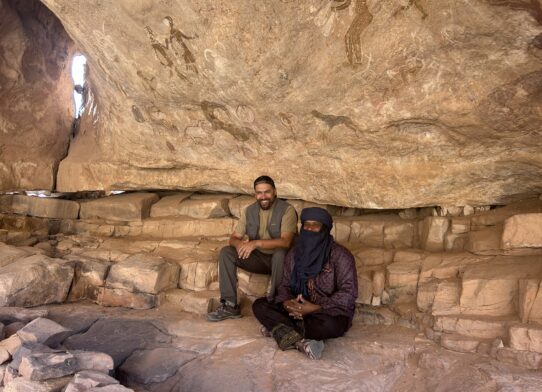 ▲ Hassan and Tahinou at a Day 4 rock art site.
▲ Hassan and Tahinou at a Day 4 rock art site.
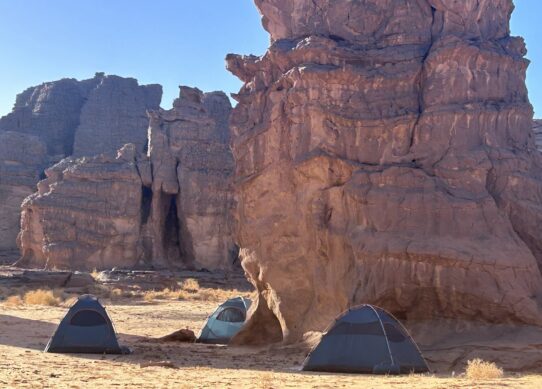 ▲ Day 3 campsite – our campsites always seemed to be spectacular and Day 3 was certainly a good one. There were three tents for the three softie tourists.
▲ Day 3 campsite – our campsites always seemed to be spectacular and Day 3 was certainly a good one. There were three tents for the three softie tourists.
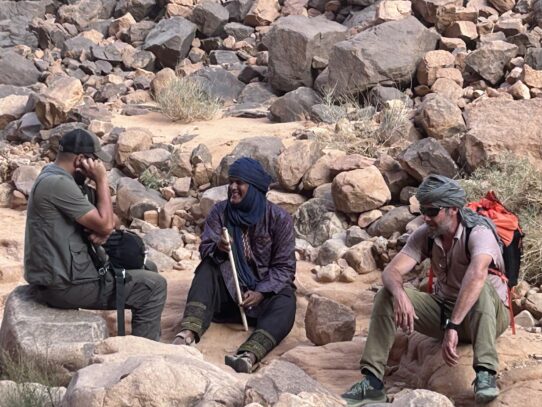 ▲ Hassan, Tahinou, Rocco – the guides (Tahinou, our Touareg leader), Hassan (who came with us from Algiers) and Rocco Ravà (our Italian tour leader) just slept out in the open, along with the ‘donkey squad’ who looked after the donkeys, the campsites, the cooking, all those important things. Well it wasn’t going to rain on them.
▲ Hassan, Tahinou, Rocco – the guides (Tahinou, our Touareg leader), Hassan (who came with us from Algiers) and Rocco Ravà (our Italian tour leader) just slept out in the open, along with the ‘donkey squad’ who looked after the donkeys, the campsites, the cooking, all those important things. Well it wasn’t going to rain on them.
 ▲ Day 5 – our final descent backing to our starting point – surely we can’t walk down that gorge? Yes we do. Fortunately those wonderful donkeys take a different route.
▲ Day 5 – our final descent backing to our starting point – surely we can’t walk down that gorge? Yes we do. Fortunately those wonderful donkeys take a different route.
 ◄ Crying Cows or the Cows that Cry – after the trek finished we made a short excursion from Djanet – just head south towards the airport, then turn east – and drive through the dunes to this famous art site. These are engravings, not paintings like those we encountered on the Tasseli N’Ajjer although we did come to one noted elephant engraving, on a horizontal rock face with a little set of steps to help you see it better! The Crying Cows are definitely crying, each with a large teardrop beneath an eye. It’s speculated that the artists were concerned – thousands of years ago – about Climate Change and the Sahara becoming increasingly inhospitable for cows.
◄ Crying Cows or the Cows that Cry – after the trek finished we made a short excursion from Djanet – just head south towards the airport, then turn east – and drive through the dunes to this famous art site. These are engravings, not paintings like those we encountered on the Tasseli N’Ajjer although we did come to one noted elephant engraving, on a horizontal rock face with a little set of steps to help you see it better! The Crying Cows are definitely crying, each with a large teardrop beneath an eye. It’s speculated that the artists were concerned – thousands of years ago – about Climate Change and the Sahara becoming increasingly inhospitable for cows.
 ▲ Stuck – but only temporarily – in the ‘fish-fash’ in Libya in 2004. The trip to the Crying Cows was through ‘vraie Sahara,’ the picturebook sandy stuff, like Maureen and I crossed in Libya 20 years ago.
▲ Stuck – but only temporarily – in the ‘fish-fash’ in Libya in 2004. The trip to the Crying Cows was through ‘vraie Sahara,’ the picturebook sandy stuff, like Maureen and I crossed in Libya 20 years ago.
